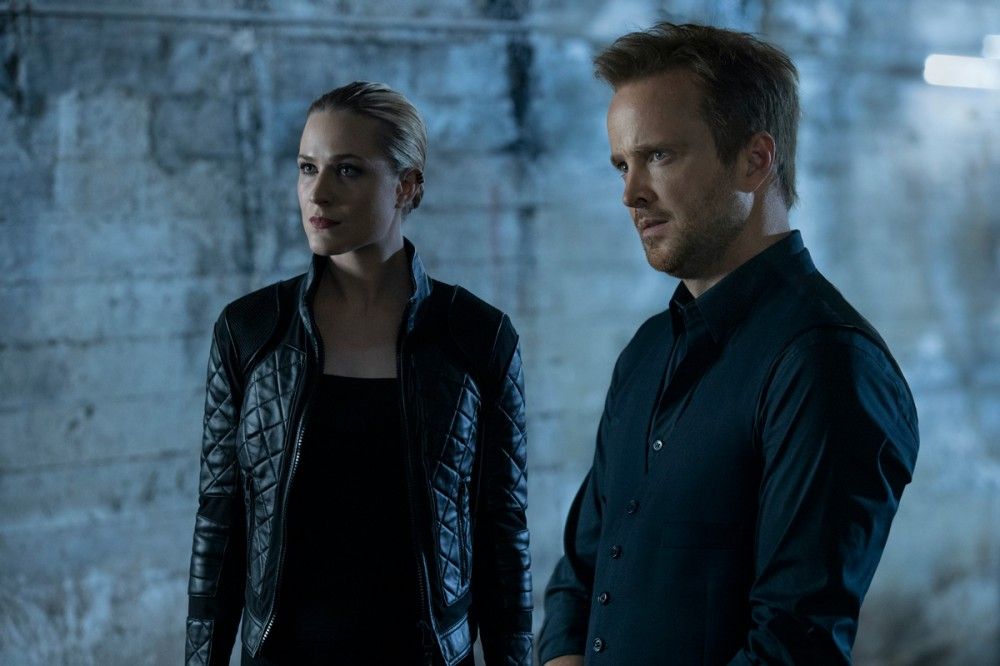
'Westworld' Recap: Data, Dumped
has spent two seasons showing us robots trying to break free of their human masters. The big reveal of Season Three is that humanity is hardly any freer — an irony at the heart of this week’s episode (“Genre”). In order to send our world crashing down, Dolores’ secret plan is to liberate us in the same way she did with her robot peers. It isn’t easy.
As Caleb tries to help our revolutionary heroine abduct Liam Dempsey Sr., the Incite exec who’s basically a living access code for its supercomputer Rehoboam, he gets dosed with a designer drug. It’s called Genre. Its high is altering a user’s perception of reality according to movie archetypes. One moment, everything’s black and white, and a noir potboiler’s horn section is wailing away. The next, “Ride of the Valkyries” blares as an action-adventure car chase/shootout goes down. (To be fair, he really is getting shot at.) Another flip and Caleb’s staring longingly at Dolores, accompanied by the theme from Love Story. Minutes later, he and his crew (including his mercenary pals, played by and Marshawn Lynch) are sauntering along stylishly to the tune of Iggy Pop’s “Nightclubbing.” Later on, the theme from The Shining pops up as well, just in case you were wondering if any aspect of cinema history is sacred to this show.
Eventually, Dolores gets what she wants. With the help of the host version of Dempsey’s security guru, Connells — who’ll eventually sacrifice him/herself to preserve the plan — she logs into Rehoboam with Liam’s biometric “key” and sends everyone on Earth their file simultaneously. (Congrats to the Incite IT department for keeping the server up and running!) Soon, people are fighting and frolicking in the streets. Imagine a mild apocalypse triggered by someone using an email’s reply-all function, and voila!
It’s a devastating blow against Serac, the control freak who, in many ways, is the episode’s protagonist. Flashbacks and voiceover narration detail how he and his brother survived the nuclear annihilation of Paris and went on to design the supercomputer as a way to take the guesswork out of human progress, staving off our self-inflicted extinction in the process.
The problem is that some pesky people are simply impossible to predict. These anomalies include his genius brother, whose mind and body eventually start breaking down. “As long as they are a part of us,” says the visionary inventor of these “outliers,” then “there is no future for us.”
There are a couple of options for these folks. Some, like Caleb, are sent off to war to be eliminated, meat-grinder style. Others, like the beloved brother, are sent to reeducation camps, where Serac and his technicians can attempt to rewire their unpredictable brains into more Rehoboam-friendly patterns. The tech genius reveals all this to his angry benefactor Liam Dempsey Sr….just before he commits an unpredictable act of his own by killing the billionaire and staging it to look like the result of a plane crash.
Unfortunately for him, Dolores just created billions of anomalies with a single keystroke. Oops!
Look, sociopathic tech gurus are a dime a dozen, and it’s not a stretch to believe that Serac would orchestrate some extremely shady shenanigans in order to preserve their fortunes, further their visions for society etc. But getting their hands dirty directly by murking someone themselves? That’s a bit harder to swallow — the stuff of comic-book supervillains like Lex Luthor, not real-life oligarchs. It’s like watching a version of The Social Network in which Mark Zuckerberg beats the Winklevoss twins to death with his bare hands. (The demise of Liam Jr., who meets his maker when he finally pisses off Lena Waithe’s character one too many times, is a bit more believable given that she’s a gun for hire.)
It’s worth noting here that all of this might have gone down a bit more smoothly had his story been a gradual reveal from episode to episode. This installment is basically a data dump — literally and figuratively — in which his life story, raison d’être, and mad plans for the future are all delivered in big clunky chunks of exposition. Compare that to the mythic sweep and power of the comparable Akecheta spotlight episode from last season, and the Serac arc comes up short. Think about the leisurely pace with which the show got us up close and personal with Dolores, Maeve, Bernard, the Man in Black — a much better approach, no?
And where does all this leave Westworld itself? One of Season Two’s big reveals was that the theme park’s true aim was to collect behavioral data on all of its guests. It’s this information that Serac has been trying to retrieve, first his mole Charlotte Hale, then by attempting to abduct Dolores now that she’s downloaded it all into her brain.
But he already has data on everyone on the planet — a metric shit-ton of it, in fact. If you’ve already got sufficient information to predict not only someone’s suicide but the time, place, and method as well, the question is then: What could the Westworld intel possibly tell you that you don’t already know? At this stage in the game, it would make more sense if Serac were hunting not for the information gathered by the hosts, but for the hosts themselves. Now that some of them have achieved sentience, they’ve thrown a massive monkeywrench into the works. Superhuman cyborgs don’t fit into a supercomputer’s calculations.
So capturing Dolores to study her mind, or even just removing her from the chessboard altogether, makes more sense for Monsieur Serac than trying to hack her brain to find out what people did on their Westworld vacation. We can live with him being a supervillain. But even a megalomaniac’s master plan at least needs to make some sense.
Previously: A Self-Made Woman



